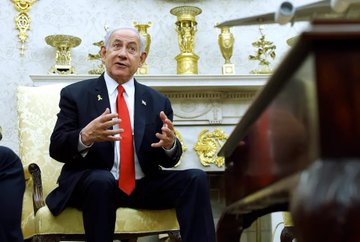The post India and Pakistan step up military strikes amid calls to de-escalate first appeared on Trump News – trump-news.org.
Day: May 10, 2025


Greetings from Los Angeles where the Milken Global Conference concluded earlier this week. For the uninitiated, Milken is a key stop on the conference circuit for many business and finance leaders—a great way to escape Manhattan to brush shoulders with industry titans and top policymakers in Beverly Hills.
It is by no means a climate conference. This year, public sessions with U.S. Treasury Secretary Scott Bessent and NVIDIA CEO Jensen Huang drew packed ballrooms. But, to many, the real draw of the conference is the behind-the-scenes discussions—an opportunity for information gathering and dealmaking.
[time-brightcove not-tgx=”true”]
For me, Milken is a great place to take the pulse on how key figures in the world of business and finance are feeling about energy, climate, and related issues. There is no doubt that climate has slipped from center stage as CEOs contend with tariffs and what might diplomatically be called a fast-changing policy environment. At the same time, it may come as a surprise to those who just follow the headlines, but the issue remains well-placed on the corporate agenda—not just in the ballroom discussion panels of the Beverly Hilton at Milken but in the behind-the-scenes executive conversations taking place in private meeting rooms, nearby restaurants, and even just the crowded hallways.
The picture that emerges to me is a dynamic one. Companies are trying to navigate an increase in climate regulation in many jurisdictions around the world while at the same time contending with a U.S. government that doesn’t want to hear about it. They are trying to protect their operations from the risks posed by climate change while conserving their financial resources in uncertain economic times.
“I’ve had hundreds of conversations since the election. I’ve never spoken with a company that said, ‘You know what? We’re going to let go of our net-zero target,’” said Nili Gilbert, vice chair at Carbon Direct, a company that invests in carbon management, on a Milken panel. “However, there is a lot of conversation going on about the interim strategy.”
My conversations at Milken will inform my reporting in the weeks to come, but for now I want to highlight a few things that stood out to me:
Physical risk
Much of the public discussion at the intersection of business and climate has focused on how companies can decrease their emissions. But companies have also been forced to look at how the physical risks of climate change may affect their operations. That rethinking is the result of both climate disclosure rules in Europe that require companies to assess how climate change threatens their operations, and recent climate-linked disasters that have brought those realities home.
Many companies want to avoid talking about climate risk directly. It’s not exactly a great PR move. But a careful look at many companies’ more recent sustainability initiatives makes the link apparent. Think of an agriculture company that helps farmers in the supply chain use less water or a fashion company diversifying where it buys materials. “Being able to map those impacts and hazards is super important,” said Melissa Fifield, who runs the BMO Climate Institute, on a panel I moderated focused on water and climate. “It’s a material impact to a lot of companies.”
Investment speed
Climate isn’t an island. The trillions in investment that the world needs to mitigate and adapt to climate change will come in forms that might otherwise be classified broadly as infrastructure, venture capital, or private equity. And the uncertainty of the moment—political and economic—has made companies and investors reluctant to make big bets and instead focus on conserving cash.
“These asset owners… want to focus on climate and infrastructure,” said Mark Berryman, partner at Capricorn Investment Group, an impact investing fund, on a Milken panel. But “they may just kind of tighten their belt in general, even if it was not a climate focused investment,”
AI, meanwhile, is a bright spot for how companies might focus their investment. As I’ve written before, the race to build data centers has created a race to build clean energy.
Financial innovation
Innovation typically draws to mind new technologies, but financial innovation can be just as important to bring clean energy to market.
Across the conference, it was reassuring to hear leaders at the intersection of climate and finance talk about different ways companies may soon be able to raise the money necessary to bring climate projects to life. That includes long-standing conversations like carbon markets and blended finance, where public or philanthropic dollars are combined with return-oriented investment. But it also includes new vehicles like private credit, an emerging asset class where investors outside of typical banks lend directly to companies.
Ultimately, financial innovation is a key ingredient to any energy transition, and these questions will need to be settled.
To get this story in your inbox, subscribe to the TIME CO2 Leadership Report newsletter here.
The post How Business and Finance Are Really Talking About Climate Change first appeared on Trump News – trump-news.org.
The post Her Sport’s founder says postponing Munster Camogie final is not in best interests of players first appeared on Trump News – trump-news.org.
The post Will Pope Leo XIV accept LGBTQ+ people as Francis did? Here’s why advocates have hope. first appeared on Trump News – trump-news.org.
The post Woman Reconnects With Ex On Facebook After 27 Years, Now They’re Married first appeared on Trump News – trump-news.org.

The post One Detail About Trump’s Pick for Surgeon General Has Haunted Me for Years. Get Ready. first appeared on FBI Reform – fbireform.com.
There are more shares by osint. Some having mortars right next to village buildings.
— IAMATTHETOP
(@NamanBhan) May 10, 2025
The post @OsintTV @noturgoddessss There are more shares by osint. Some having mortars right next to village buildings. first appeared on JOSSICA – jossica.com.
C’est les asiatiques qui monopolisent et salissent les espaces publics ?
Tu habites dans quelle ville ? Qu’on fasse un peu d’OSINT
— Big Smoke (@big_ytb) May 10, 2025
The post @OkapiLeeuw @Shaina69008 C’est les asiatiques qui monopolisent et salissent les espaces publics ? Tu habites dans quelle ville ? Qu’on fasse un peu d’OSINT first appeared on JOSSICA – jossica.com.
BLA insurgents destroy communications tower in Haji Shahr area of Kachhi #Pakistan #OSINT #GEOINT https://t.co/L0T4HdQncr
— Geopolitical Report (@GeoPioneerInc) May 10, 2025
The post BLA insurgents destroy communications tower in Haji Shahr area of Kachhi #Pakistan #OSINT #GEOINT geopolitical.report/bla-insurgents… first appeared on JOSSICA – jossica.com.

Trump – Netanyahu conflict: events, analysis, predictions
The tension between **Donald Trump** and **Benjamin Netanyahu** has been escalating, particularly as Trump prepares for his upcoming **Gulf visit**. Here’s a breakdown of the situation:
### **Recent Events**
– Trump has been **frustrated** with Netanyahu over several issues, including **Iran nuclear talks** and **the war in Gaza**.
– Trump’s administration has **resisted Israeli pressure** to launch a preemptive strike on Iran, despite Netanyahu’s strong stance.
– The U.S. has **backed Israel’s military actions** in Gaza and Yemen but is now **pushing for a ceasefire** with the Houthis, which has irritated Netanyahu.
– Trump’s **Secretary of Defense, Pete Hegseth, canceled a visit to Israel**, signaling further diplomatic strain.
### **Analysis**
– Trump appears to be **prioritizing his Gulf alliances** over Netanyahu’s concerns, particularly regarding Iran and Yemen.
– Netanyahu, on the other hand, is **focused on maintaining Israeli security dominance**, which sometimes clashes with Trump’s broader geopolitical strategy.
– While Trump has been **supportive of Israel’s military actions**, his **unilateral decision-making** on key issues like Iran and Yemen suggests he’s willing to **sideline Netanyahu** when necessary.
### **Predictions**
– Trump may **continue to distance himself** from Netanyahu if Israeli policies interfere with his Gulf strategy.
– Netanyahu could **push back diplomatically**, possibly leveraging **Congressional allies** to pressure Trump.
– The **Iran nuclear talks** will remain a major flashpoint—if Trump **softens his stance**, Netanyahu’s frustration could escalate further.
This dynamic is fascinating from a **geopolitical and strategic** standpoint. What’s your take on how this will unfold?
–
–
Grok
x.com/i/grok/share/v
The relationship between Donald Trump and Benjamin Netanyahu has been complex, marked by close collaboration during Trump’s first term but also underlying tensions that have surfaced in recent interactions. Below is a summary of key events, analysis of their dynamic, and predictions based on available information up to May 10, 2025.
Key Events
Historical Context (2017-2021):
During Trump’s first term, the U.S.-Israel relationship under Netanyahu was notably strong. Trump implemented policies favorable to Israel, including moving the U.S. embassy to Jerusalem, recognizing Israeli sovereignty over the Golan Heights, and brokering the Abraham Accords, normalizing relations between Israel and several Arab states.
Tensions emerged late in Trump’s first term when Netanyahu considered annexing parts of the West Bank, believing it aligned with Trump’s “Deal of the Century.” Trump opposed this move, especially as it risked complicating his 2020 reelection campaign. Further strain occurred when Netanyahu congratulated Joe Biden on his 2020 election win, which Trump perceived as disloyalty, reportedly saying, “F**k him.”
2025 Meetings and Ceasefire Negotiations:
February 2025: Netanyahu was the first foreign leader to visit Trump at the White House after his second inauguration. The meeting focused on the Gaza ceasefire, with Trump claiming credit for the initial six-week truce that began January 19, 2025, which led to the release of 18 hostages and 583 Palestinian prisoners. Discussions also covered normalizing Israel-Saudi relations and countering Iran. However, Trump’s controversial proposal for the U.S. to “take over” Gaza and resettle Palestinians elsewhere raised concerns among Arab mediators and strained ceasefire talks.
April 2025: Netanyahu’s second visit addressed tariffs, Iran, and the Gaza war, which had resumed after a ceasefire breakdown. Trump imposed a 17% tariff on Israeli exports and announced U.S.-Iran nuclear talks, both of which caught Netanyahu off guard. Netanyahu sought exemptions from tariffs and a hardline stance on Iran but left without clear commitments.
Ceasefire Breakdown: By May 2025, Israel signaled plans for a full-scale Gaza offensive, aiming to occupy and depopulate parts of the Strip, inspired partly by Trump’s earlier “Riviera of the Middle East” vision. This move, set to begin after Trump’s Middle East tour (May 13, 2025), has heightened tensions, as Trump’s administration appears less engaged, focusing instead on Saudi-Israeli normalization.
Regional Developments:
Trump’s push for Saudi-Israeli normalization faces obstacles, as Saudi Arabia insists on a Palestinian state, a prospect opposed by Netanyahu’s coalition.
Houthi attacks, inc…









